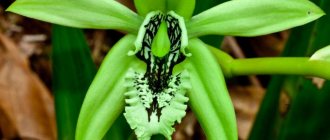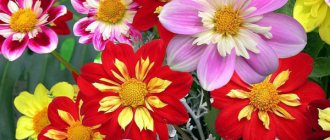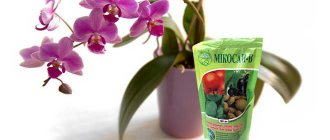Dahlia flowering dates
Early varieties of dahlias begin to bloom 30-40 days after planting, later varieties - after 70-80 days. Most species of this plant bloom in June. The flowering period lasts until the first frost and ends in September-October. Subject to the storage conditions of dahlia tubers in winter and good weather conditions in spring, earlier flowering can be achieved, starting at the end of May.
Sowing seeds and planting dates
Annual dahlias variety Cardinal's Children
The timing of sowing seeds for seedlings depends on the region: in the middle zone, planting begins in early April, in the south - at the end of March, in the northern and eastern regions - in mid-April .
For sowing you will need containers, soil and seeds. The ideal container for growing seedlings is wide plastic containers or boxes with a height of 7-10 cm. If they do not have drainage holes, they must be made with a sharp knife or nail.
You can sow dahlias in peat tablets or peat pots filled with soil. These materials allow moisture to pass through well.
The soil for seedlings should be loose and fertile. If you prepare the soil mixture yourself, then take 2 parts of humus and turf soil and 1 part of river sand. You can also mix store-bought flower soil and garden soil with the addition of loosening materials: vermiculite or perlite.
The container is filled with soil, compacted a little and watered with warm water so that the seeds have enough moisture to germinate.
Before sowing, the seeds are kept for 30 minutes in a light pink solution of potassium permanganate. After soaking, they are dried for 5–10 minutes and sown, laid out on the soil surface 2–3 cm apart, slightly pressing into the ground.
The optimal seeding depth is 1.5-2 cm. After planting, the soil is sprinkled with a layer of river sand on top to prevent “blackleg”.
The crops are covered with film and placed in a warm, bright place with an air temperature of 20-23°C.
Containers are ventilated daily. After 7 days, the first shoots appear and from this moment the film is removed.
When to plant dahlias in spring
Dahlias do not tolerate frosty weather well; during short frosts, the tubers can rot and die. Therefore, the timing of planting plants in open ground depends on weather conditions.
When to plant in spring according to the lunar calendar 2018
According to the lunar calendar of gardeners and gardeners, it is advisable to plant flower plants during the period of the waxing Moon. This is due to the fact that during the growth phase the satellite attracts all the water on the planet, including the sap in plant cells. In spring 2022, dahlias can be planted on the following dates: May 4-6, 14, 16-24, 26-28. Astrologers recommend planting later varieties on June 6-7, 10-11, 15-20, 22-25.
If the weather deteriorates on favorable days according to the lunar calendar, it is necessary to reschedule the procedure to another time, while avoiding the days of the full moon and new moon and the dates closest to them.
When to plant
Traditionally, the root crops of this flower are planted in the soil in the middle or end of May, when the ground has warmed up sufficiently. In addition, during this period there are most often no sudden changes in weather, cold rains and gusty winds. The day for planting must be chosen as warm and sunny.
In regions with a more favorable climate, dahlias can be planted in open ground in March-April. At the same time, it is necessary to carefully monitor weather forecasts and, if there is a threat of frost, provide the plants with careful shelter. At the same time, tubers pre-sprouted at home should be replanted.
When dahlias bloom - care during this period
Dahlias are widely used to decorate gardens and vegetable gardens.
Gardeners are attracted by the ease of cultivation, perenniality, relative cheapness, variety and beauty of flowers. This flower is quite unpretentious; it can be planted under trees, in partial shade. The plant comes from Mexico, so it loves warm and humid climates. It is advisable to protect it from gusts of north wind and plant it on the south side of the site. Dahlia loves space and fresh air - the area around it should be cleared of weeds. You should not plant the plant in lowlands and with close groundwater (60 cm). This will cause the root system to rot.
What to do to make dahlias bloom as early as possible
In order for the flowering period of the bushes to come as quickly as possible, a month before planting in open ground, it is necessary to germinate the tubers, thereby preparing the plant for favorable and productive cultivation. To do this, in April you should sprinkle the root vegetables with a moistened coconut substrate, peat or sawdust and sand, and then place them in a warm place: a greenhouse, greenhouse or on a windowsill. The emerging sprouts can be planted in separate containers, while providing them with timely watering and additional care.
After 3-4 weeks, the tubers with young sprouts need to be moved to a permanent place. When planting dahlias in open ground, add special fertilizers. As the leaves appear, pinch the shoots. It is necessary to pinch the top of the stem above the third or fourth leaf. Carry out this procedure with pruning shears and disinfect the instrument after each removal. If you follow these recommendations, dahlias will bloom much earlier than expected.
What to do to make flowers bloom faster
A guarantee of timely and abundant flowering is good planting material.
How to save tubers for later planting:
- In the southern regions of Russia, tubers do not need to be dug up for the winter; it is enough to cut the stems and cover the plant with any material. In the first days with above-zero temperatures, you need to remove the winter covers from the dahlias and cover them with film to warm up the soil faster.
- In the northern regions, it is better to dig up the tubers, dry them well and put them in a cellar for storage. Tubers are dug up from mid-October to mid-October. It all depends on the specific autumn.
To speed up the flowering of dahlias, you need to plant them in the ground as almost mature plants, perhaps already with buds. To do this, it is necessary to plant the same tubers for seedlings in a large container earlier than expected. By the time it is planted in open ground, the dahlia will have grown into a mature plant, possibly with flowers. It must be planted in prepared soil and in the right place. This needs to be done with a lump of earth where it grew.
In order for dahlias to bloom profusely and luxuriantly, it is important to observe certain conditions. The soil should be nutritious, moist, loose and free of weeds. The bush needs to be thinned out in a timely manner, pinched and pinched, and faded buds removed. It is important to properly store the tubers before planting in the ground. All this will help you get a beautiful flowering dahlia bush.
How to get large flowers
To get large flowers and powerful stems, it is necessary to correctly form the bush and promptly remove the side shoots that appear in the axils of the leaves. This is due to the fact that the extra shoots take a lot of nutrients and prevent the flowers from developing. Therefore, pinching plants of medium and tall varieties is a mandatory procedure to obtain large buds.
Professional flower growers advise leaving 2-3 shoots on the tuber and cutting off excess stems throughout the season. In addition, it is necessary to remove the leaves at the bottom of the bush and cut off wilted flowers. This will provide light, heat and air access to the soil and will stimulate rapid plant growth.
Decorative dahlias are highly susceptible to various diseases and attacks by harmful insects. In order for young buds to remain strong, and subsequently large voluminous flowers to appear, it is necessary to regularly treat the bushes with special anti-pest agents, for example, solutions of celandine or wormwood, soap solution or systemic insecticides.
In addition, dahlias need proper moderate watering, timely fertilization with phosphorus and potassium, loosening the soil, cutting off dried leaves and removing faded inflorescences. Such comprehensive measures will allow flowers to develop and reach large sizes.
Flower care
Caring for these flowers is not at all difficult. This, of course, is the formation of a bush, watering and fertilizing. When dahlias are just starting to grow, you also need to remove weeds near the bushes and loosen the soil after watering.
They begin to form bushes as soon as they grow a little. Leave 2-3 stems on the plant, remove excess stems (they can be used when cutting dahlias). The side shoots growing from the axils of the leaves are pinched. In low-growing dahlias, pinch off the top after the 4th pair of leaves, then pinch off the top of the grown side stems after the 2nd pair of leaves. The bush becomes small and branched.
In order for the bush to constantly produce buds, it is necessary to remove faded inflorescences (after all, we practically do not collect seeds from perennials). The lower leaves of the plant are also removed to a height of 40 cm (in tall varieties).
Watering is carried out regularly - once every 7-10 days. The soil near the bushes should be constantly moist, but care must be taken to ensure that the water does not stagnate near the bushes, otherwise the tubers may rot.
During watering, you can also feed the plant (once every 2 weeks), adding mineral or organic fertilizers to the water. At the beginning of growth, ammonium nitrate is applied, at the end of summer and autumn - superphosphate and potassium fertilizer. The following infusions are made from organic fertilizers:
- mullein (1 l: 10 l water);
- bird droppings (0.5l: 10l water);
- from fermented grass.
In addition to root feeding, foliar feeding can also be done on the leaf.
How to prolong the flowering of dahlias
Types of dahlias that bloom for quite a long time do not require additional care and can delight with their flowers for a long time. To increase the flowering period of annual plant varieties, you should regularly inspect the bushes and pick off drooping and dried heads. This method of care will prevent the plant from becoming depleted and will stimulate the formation of new buds.
In order for the flowering to be abundant and long-lasting, it is necessary to properly fertilize dahlias. It is better to carry out the last fertilizing no later than the end of July. In this case, the bushes will not actively grow greenery, and the flowers will receive more nutrients and will remain lush and beautiful longer.
At the end of August or beginning of September, hilling should be carried out, forming a small mound of earth around each plant. In this way, you can protect the tubers from strong differences in day and night temperatures and the first autumn frosts.
In addition, if weather conditions worsen and there is a threat of short-term sub-zero air temperatures, you should carefully cover the bushes with lightweight materials: polyethylene, geotextile or burlap. When warm weather sets in, the protective covering must be removed and the dahlia stems carefully straightened.
How dahlias bloom
How to shape dahlias for the right bush
When dahlias bloom, the garden seems to be transformed. Bright, juicy, large flowers become a decoration for any flower bed, a wonderful decoration for a house, fence and other garden buildings.
Exquisite miracle
There are a huge number of plant varieties: perennial and annual, early, late, tall and short. The flowers themselves can be different in color, size, shape, doubleness, etc.
Dahlias - from planting to flowering
May 3, 2022 / Gennady Litavrin, member of the Moscow Flower Growers Club on Novinsky
Dahlias began to be grown in Russian gardens in the mid-19th century. They immediately gained recognition among flower growers. And this is not surprising. After all, such flowers, varied in shape, color and size, cannot leave anyone indifferent. It should be noted that they bloom for a very long time - from July until frost. I fell in love with dahlias as a child, when we were visiting my mother’s friend. They shocked me to such an extent that I asked my mother to visit her friend again and again. Just to admire these wonderful flowers.
Years passed, and the parents purchased a garden plot. I was already a student, but I remembered those flowers well from my childhood. The first dahlia planted was the “Phantom” variety, and then it started… The collection reached more than 150 varieties, and this at a time when it was very difficult to acquire the desired variety. I met the breeders of these flowers, such as Sukhanov V.M., Sidorova A.N., Nessonova I.N., Sharonova M.F., fortunately, they lived in the Moscow region. But I couldn’t resist a trip to Riga to the famous breeder, creator of popular dahlia varieties, K.K. Ruks. After all, it’s especially nice to receive new items first-hand. As a rule, plants grown from cuttings were purchased. What a joy it is when you come home with a box of treasured varieties, then you look forward to the flowering of new varieties, most of which simply shocked you with their perfection and beauty.
Soil preparation
Soil preparation begins in the fall. The soil must have a neutral reaction. The plant does not like acidic soil and does not tolerate alkaline soil. If necessary, in the fall or under the predecessor, slaked lime, chalk to reduce acidity, and peat to neutralize the alkaline environment are added to the soil.
One of the main requirements is good soil permeability. For structuring, coarse river sand or fine gravel is added for digging.
For autumn digging, 2 buckets of rotted organic matter per square and 25 g of superphosphate are added to the soil. In spring, a mixture of compost and wood ash is scattered under harrowing. You can add potassium sulfate instead of ash at the rate of 20 g per square.
The predecessors of dahlias in the garden cannot be plants from the Asteraceae family. Common pests and diseases accumulate in the soil. If you plant dalia in one place for two years in a row, the splendor of flowering bushes will decrease.
When to plant dahlias?
The timing of planting plants in unprotected soil is directly dependent on the climatic conditions of a particular region. Usually, ready-made dahlia seedlings grown from tubers, seeds or cuttings are planted. Read more about this in the article “Working methods of propagating dahlias: from seeds, tubers, cuttings.”
When to plant dahlias in spring/summer:
- in the south of Russia - in April;
- in the middle zone - in the second half of May ;
- in the northern regions - in early or mid-June .
If the dahlias were planted too early and the young shoots turned black due to frost damage, do not rush to uproot and throw away the plants. The underground part could have survived. The buds of the root collar do not start growing all at once. There is a chance that new shoots will appear in place of dead sprouts.
Dahlia propagation
Gardeners often share their dahlias with friends and neighbors, because propagating them is not at all difficult. This can be done in three ways:
- dividing tubers;
- cuttings;
- seeds (preferably for annual varieties).
The division of tubers is carried out before planting flowers. Each division must have at least one growth point (bud), but it is better to leave three. After dividing the cut area, it is treated with charcoal, ash, or possibly iodine, then dried.
Also, experienced gardeners attach a tag with the name of the variety to each division, so as not to confuse dahlia varieties in the future.
Another propagation method, also quite effective, is cuttings. This does not cause harm to the plant itself, since when the bushes are formed, excess cuttings remain in sufficient quantities. It is advisable to dip the cuttings in a growth stimulator and then plant them in moist soil. Containers with planted cuttings must be covered with film and placed in a warm and bright place for germination. In such conditions, cuttings take root very well. After the plant begins to grow new shoots, they are moved to a cooler place so that they do not stretch.
As you can see, growing dahlias is not that difficult. If you follow the recommendations that we described in this article, the gorgeous buds will delight you with their bright flowering from mid-summer until frost.
Choosing a place to grow dahlias
Dahlias (the scientific name for dahlias) are not very fussy, however, they like warmth, need protection from gusts of wind and do not bloom in the shade. Choose a sunny area, closed on the north side by a wall, fence or dense hedge. Penumbra is acceptable - the space under the sparse crown of trees. It is important that there is enough space and fresh air around.
IN THE PHOTO: When choosing a place for dahlias, it is better if there is a fence or wall located on the north side of it.
Dahlias should not be planted in lowlands. Cold air accumulates there, which can kill plants!
Growing dahlias is possible on fertile, permeable soils with good structure. Groundwater should not reach the surface closer than 60–70 cm . The slightest stagnation leads to rotting of the root tubers. It will not be possible to grow planting material for next year in such conditions.
Low soil permeability can be improved by adding:
- coarse river sand;
- fine gravel;
- coal slag (not suitable if the soil on the site has a neutral or alkaline pH reaction).
The soil structure is improved by adding organic matter!
When planting dahlias, check the acid-base (pH) reaction of the soil. It should be neutral, or at least slightly acidic. Acidic soil is neutralized with slaked lime at the rate of: 100 grams for non-medium acid soils and 150 grams for very acidic soils per 1 sq. m. meter _ An indicator of highly acidic soil will be water standing for a long time in the spring on the site, mosses and horsetails in the vegetation cover. Strongly alkaline soils are alkalized by adding peat. However, this procedure will have to be carried out annually, and even in this case, the dahlias will not grow well.
When tubers form, plants consume a large amount of nutrients from the soil, depleting it. Planting dahlias in the same place for the second year is not recommended.
Dahlias are close relatives of asters. They consume the same substances from the soil and suffer from the same diseases. Therefore, it is not recommended to plant them after each other.
The plot of land selected for dahlias is prepared in advance. During autumn digging, three to five kilograms per square meter of humus or compost are added. In the spring, mature compost is mixed with wood ash, scattered throughout the area and the top layer of soil is loosened shallowly using a rake.
Requirements for the site and soil
In order for dahlias to delight with lush flowering, it is recommended to choose a planting site on the south side of the building - the plant loves the sun and loves warmth.
Attention! Dalias should not be placed in lowlands where water stagnates. Dahlias freeze at elevations blown by northern winds and dry out under the influence of hot air masses from the south, evaporating moisture.
Preparing a site for planting dahlias begins with determining the soil structure. In case of increased acidity, add slaked lime and dilute the alkaline soil with peat. If the soil on the site is heavy due to excess clay, add the following to improve breathability:
- coarse sand;
- coal screenings;
- crushed gravel.
The place for planting dahlias is dug up in the fall and 5 kg of organic matter is added per 1 sq. m. m area. In the spring, the soil is loosened, holes are made, into which a bucket of compost is poured, and ash is added. To support the stems of the plants, stakes treated with copper sulfate are driven in.
Dahlias: growing and care
Caring for dahlias is simple, but requires systematicity. It is important to follow the planting pattern, regularly water and feed the plants. And to achieve the best results, it is recommended to correctly form the bush.
How to plant dahlias?
To get beautiful large dahlia flowers, planting must be carried out in accordance with the following scheme:
- 80 x 60 cm - for tall varieties;
- 60 x 45 cm - for medium-sized children;
- 40 x 30 cm - for dwarf dahlias;
- 100 x 100 cm - for cutting.
Before planting dahlia tubers, the selected area is leveled and planting holes are dug. For tall varieties, strong stakes from four centimeters in diameter and up to two meters in height are driven in. This is necessary to protect brittle shoots from damage in strong winds, as well as from drooping towards the ground due to the heaviness of the inflorescences. Medium-sized and dwarf varieties do not need support.
IN THE PHOTO: Before planting seedlings of tall varieties of dahlias, it is necessary to dig supporting pegs near the holes.
To prevent dahlias from being damaged when transplanted from containers to beds, they are watered generously within 4 hours. The earthen lump will become wet, and it will become much easier to pull the root system out of the pot. The soil mixture is not removed from the roots; the plant is placed in a planting hole, buried 4–5 cm below ground level. The remaining hole is covered to the top with garden soil.
Video: how to plant dahlias; preparing the pit, planting a tuber and grown dahlia
LePlants.ru editorial advice: when you start planting dahlias, don’t forget to make watering ditches around each bush and fill them with water! This will ensure the soil is evenly compacted around the roots.
Caring for dahlias
Dahlias have a powerful ground part, but the root system that feeds it is relatively small. For full development, planting and caring for dahlias is carried out with regular feeding and watering.
When adding water, the soil is poured so that it gets wet to a depth of 25–30 cm. Deeper penetration of moisture can cause stagnation and provoke rotting. You can read even more about the problems that arise when growing dahlias and how to combat them in our article “Diseases and pests of dahlias: identify, fight, and take preventive measures.”
IN THE PHOTO: Dahlias should be watered abundantly, especially in dry weather. However, under no circumstances should you look at flowers, as the lovely woman in the photo does.
Fertilize a flower bed three times during the summer : during the intensive growth of green mass, when planting flower buds and during the flowering period. Feed with liquid fertilizer, pouring two to five liters (depending on size) under each bush.
General description and popular varieties
Herbaceous perennial plants with hollow stems include 24 species and are found naturally in the mountains of Mexico, Colombia, and the highlands of Guatemala. The ancient Aztecs ate dalia roots instead of potatoes, used them as a medicine for seizures, and as an amulet in rituals. The taste of dahlia tubers brought by sailors did not impress Europeans, who cultivated both vegetables and grain crops. They appreciated the bright beauty of the flowers in the botanical garden of Madrid, and breeders began to breed hybrid varieties.
Reference! Dahlia shoots and leaves die off; in tropical climates, the tubers overwinter in the ground. In mid-latitudes, the roots of the plant are dug up in the fall, otherwise they freeze out.
Buds form in the lower part of last year's shoots, on the necks of tubers. The feathery beautiful leaves grow up to 40 cm in length. The flowers are shaped like baskets with many petals.
In some types of dahlias the stem stretches up to 2 m in height, in border varieties it does not exceed half a meter. Main types of culture:
Simple dahlias are low bushes with flowers on which the petals are arranged in one row.
- Cactus dahlias are attractive with terry corollas with a diameter of 25 cm, which seem unkempt. The ends of the petals curl into narrow tubes and look like needles.
- Blanket dahlias grow up to a meter in height and surprise with their variety of shades and unusual flower shapes with vertical rows of twisted petals.
- Large terry corollas with a voluminous center, blooming on the shoots of lotus dahlias, resemble a charming nymph growing in ponds.
- Gardeners value collared varieties, in which the inner tubular and outer flat petals form a cape around the bud.
- Decorative varieties of the plant form densely double inflorescences with wavy edges, in the center of which the tongues curl into a spiral and twist.
The beauty of the inflorescences inspired breeders to create varieties, the number of which exceeds one and a half thousand. The most sophisticated and popular hybrids include:
- Barbe Bleue. The cactus dahlia captivates with its large double flowers of bright scarlet color, which turn blue-violet in the fall.
- Fluerel. Nymphaeum dalia is an elegant bush with long shoots and many dazzling white corollas with a diameter of at least 20 cm.
- Romeo. A miniature plant whose small flowers are formed by one row of red petals.
- Funny Face. Yellow spherical dahlias with contrasting scarlet splashes bloom in waves and look great in bouquets.
- Lambada. Anemoid variety of dalia. The edges of the creamy terry buds are decorated with pink petals.
- Franz Kafka. The small blue or purple dahlia flowers are shaped like pompoms.
- Marble Ball. A variety up to 80 cm high is bred for single plantings; its milky-white corollas, decorated with lilac touches, stand for a long time when cut.
- Karma Demolition. The almost black buds of the decorative dalia, when blooming, acquire a bright red hue.
- Aspen. A semi-cactus variety with a bush height of 60 cm is crowned with graceful snow-white flowers with petals curling at the ends.
All cultivated varieties of dahlias bred by breeders feel comfortable in the southern regions and do not overwinter in the middle zone. Plants that are stunning with abundant flowering until the end of September are planted in mixborders, on alpine hills; low-growing bushes are used to frame borders, design arrays, and create floral designs.
Romeo
Dahlia flowering
Dahlia received its proud name in honor of the Russian traveler, ethnographer and naturalist of German origin Johann Georgi. In foreign literature, the flower is known under the name “Dahlia”. South America is considered the birthplace of the dahlia. The ancient Aztecs saw it as the earthly embodiment of the sun and used it in solar cults. In modern Mexico, the flower has acquired the status of a national symbol. Since the end of the 18th century, the plant became widespread in the Old World and more than once caused a fashion boom, becoming the most popular and sought-after flower, especially among the nobility.
Dalia belongs to the Asteraceae family, has 42 species and an unimaginable many (about 15 thousand) varieties. Under natural conditions, wild dahlia can reach six meters in height. Garden cultivars of this plant are much lower - usually do not exceed one and a half meters.
Dahlia flowers can be either simple or double, sometimes spherical. In some garden species, “echoes” of wild American ancestors have been preserved, the baskets of which were composed of two forms of flowers: reed (external, not producing offspring) and tubular (internal, fruitful). The shades of dahlias are innumerable. Flowers are monochrome and variegated.
The great advantage of these plants is their rather long flowering. In the middle zone it begins approximately in mid-late June and ends with the onset of frost. Due to the long flowering period, which lasts almost until winter, dalia is nicknamed the “queen of autumn flower beds” - after all, at the time when dahlias bloom, most garden crops die off or go into winter “dormant” mode.
Types and varieties of dahlias
Dahlias have many varieties and even more varieties. The most popular types are simple, peony-shaped, cactus and semi-cactus, pompom and spherical, large-flowered, anemone-shaped and miniature. Their height ranges from 30 cm to 120 cm. The flower size is from 5-10 cm to 25 cm and more. In terms of color range, dahlias have no equal among flowers.
Simple dahlias
The inflorescences of this species are single-row, non-double or semi-double with a small diameter (10-12 cm). The height of the bushes is also small, 0.3-0.6 m. Popular varieties of this species:
- Funny boys;
- Figaro (flowers of different colors on one bush - a miracle!);
- Kelvey Sunshine;
- Romeo;
- Happy kitty;
- Twinings Smarty (an interesting variety with petals of different colors).
Flowers of this species are most often annuals from seeds that do not require special growing conditions. It is not difficult to grow their seedlings, and the roots of annuals, if desired, can be saved until next year and planted in the spring.
Peony-shaped
These dahlias are very similar to peonies. They have semi-double inflorescences measuring 12-15 cm. The height of the bushes is from 0.7 m to 1.2 m.
Popular varieties are Intrigue (interesting because at first its color is coral, towards the end of flowering it becomes crimson), Symphony (red inflorescences).
Cactus and semi-cactus
This species is especially popular among gardeners.
The inflorescences of this type of dahlia are double, needle-shaped, their diameter is 8-30 cm. The bushes vary in height (1.0-1.2 m) and usually need support.
Known varieties of cactus and semi-cactus dahlias:
- Dream (up to 20 pink flowers at a time, height 1.3 m);
- Elga (inflorescences with a diameter of 15 cm, pale pink);
- Princess Park (pink flower color, strongly twisted petals, bush height 0.5-1.0 m);
- Dahlias Klondike and Snowy Rus' (snow-white, the height of the first is up to 1.7 m, the diameter of the inflorescence is 17 cm, the height of the second is about 1 m);
- Frikvolet (bright red flowers with white tips on the petals, stem height 0.8-1.0 m);
- Orangenzon (bush height 1.2 m, large inflorescences, salmon color).
Varieties with a small bush height (0.8-1.0 m) are Alfred Grill (flowers are pink at the edges and yellow in the middle) and Pirouette (yellow flowers).
Ball and pom pom
They are a little similar to each other, but still have differences. The spherical ones are larger, the diameter of their inflorescences is 10-15 cm, for the pompom ones - no more than 5 cm. The petals of both are rolled into a tube, but if in the first up to half of the petal, then in the second the entire petal is rolled up. The height of the bushes reaches 1.2 m,
Known varieties of these species:
- Maren;
- Pagoda;
- Karat (lemon-yellow inflorescences with a diameter of 10 cm);
- Dark Spirit (dark burgundy buds measuring 5-10 cm);
- Sylvia (salmon-colored inflorescences, their size is 10 cm);
- Corner (red color at the buds).
Varieties of pompom dahlias:
- Zingaro (inflorescences 10 cm in diameter, pale pink, and yellow in the middle);
- Changeable Pompom (delicate salmon color of the bud);
- White Aster (white inflorescences);
- Franz Kafka (flower diameter 6 cm, pink color);
- Yew (dark burgundy inflorescences).
Anemoneaceae
The inflorescences of dahlias of this species are double, but if the outer petals are usually elongated, then the petals of the bud, located in the middle, are shortened. The diameter of the inflorescences is small, only 5-10 cm, the height of the stems is 0.6-0.9 m, they are strong and do not require garter to a support. Popular varieties of this species:
- Lambada (beautiful pink and white inflorescence);
- Phantom (carmine red buds with a diameter of 8 cm);
- Mambo (red inflorescences with a yellow border);
- Boogie Woogie (yellow petals closer to the center, pink and white petals at the edges, stand up well when cut).
Large-flowered
The inflorescences of this type of dahlia are the largest and reach 25-45 cm, the height of the bushes is from 0.8-1.2 m. The bushes require garter, as it often happens that such large inflorescences cannot withstand.
Interesting varieties of large-flowered dahlias:
- Firebird (red-yellow inflorescences);
- Advance (delicate, bud color from soft yellow, then pink and the bottom layer is white-cream);
- Vancouver (lilac with white tips);
- Tartan (raspberry petals with white stripes along the entire length of the petal, inflorescence size 40-45 cm);
- Calvin Floodlight (lemon yellow) and many others.
Miniature
The height of these bushes is from 25 cm to 60 cm, the inflorescences are also small 10-15 cm. Often this type of dahlia is planted in flowerpots or on borders. And if you plant them in flower pots, you can bring them indoors when frost sets in and admire the blooms at home.
Among the popular miniature dahlias, the following varieties can be listed:
- Figaro (terry annual variety, multi-colored);
- Cezanne (yellow bud color);
- Riviera (red inflorescences).
What to do to make dahlias bloom as early as possible?
To enjoy the flowering of dalia at the beginning of summer, the tubers must be prepared in advance for planting. Around April, they are dug into moist, organic-poor soil (sand, coconut fiber, peat-based soil mixture) and placed for forcing in a greenhouse, hotbed, or simply on a window sill in a room. In May, rhizomes with green shoots that have appeared are planted in the open air in a permanent place. With this approach, dahlias begin to bloom a month after planting, while in the absence of preliminary forcing, the first flowers are observed no earlier than the end of July. To avoid an unwanted shift in the flowering of dahlias, they also try not to be late with pinching. They are produced after four pairs of leaves appear on the dalia. Dwarf, border varieties of dalia and plants grown as annuals do not need pinching.
Annual dahlias
Annual dahlias are grown from seeds. To do this, choose medium and short plants; these bloom much faster. Information about the selected variety can be obtained from the description accompanying the package. The dahlia variety “Jolly Guys” is ideal for this purpose. These flowers are easy to care for and tolerate dry and hot climates well. “Cheerful guys” got their name for their bright decorative inflorescences.
Dahlias "Jolly Guys"
The selected area can be sown with seeds immediately, but it is better to grow seedlings from them and, after the seedlings have grown stronger, plant them in a place of permanent growth. Flower seedlings begin to be planted from early March to April. The seeds are placed to a depth of no more than 2–3 cm, the distance between them on all sides should be at least 2 cm.
To ensure good germination, the container with seedlings is covered with plastic wrap and then the temperature in the greenhouse is constantly maintained at about 25 ° C. The plant is picked immediately after the formation of the first full leaf. The bush is transplanted to a permanent place after the seedlings are sufficiently strong.
When planting medium and especially large varieties in the ground, you need to maintain a distance between bushes of about 65 cm; for compact plants, the distance ranges from 20 to 30 cm. Before planting, a mixture of sawdust and humus is added to the ground. One standard bucket is enough to fertilize 1 square meter. meter of garden. Then, gardeners with extensive experience recommend watering the loosened soil with a weak pink solution of manganese.
Flower planting distance
How to get large flowers?
The fewer flower ovaries on a plant, the larger they are, since all the nutrients will be directed to a few flowers, rather than dispersed over many. This rule also applies to dahlias. It is recommended to leave two or three main stems on the dalia, on which buds will subsequently appear. All the rest are removed in their infancy. In addition, it was noticed that large flowers grow on bushes driven out of young trees. Therefore, you should carefully consider the planting material and discard old tubers in advance.
Reproduction methods
In nature, the rhizome of dalia grows within 6-8 years. New shoots produce root tubers at the age of 1-2 years, the rest serve to feed the plant. Old, non-productive thickenings are darker than young ones and have rough skin with wrinkles.
Garden dahlias are propagated in several ways:
- Division of tuber roots into fragments containing 2-3 buds. The division is planted in a permanent place as it is, or shoots are first grown.
- Sowing seeds collected from dried baskets allows you to obtain unexpected flower forms due to cross-pollination.
- Cuttings - a tuber taken out early for germination is planted in a box. Sprouted cuttings with 2-3 internodes are cut off with a “heel”, rooted in a container, and planted in the ground as a formed bush, without potatoes.
- The new variety is obtained by spores. A cut branch with a flower is rooted into a container. The dried flower is stored at a temperature of 6 0 C, watered in the spring, grown and planted in the garden.
The most common first method is growing varietal dahlia from cuttings. At the same time, the properties of the mother plant are preserved.
Why do dahlias bloom poorly?
There may be several reasons. Let's mention the main ones.
- Often gardeners, in pursuit of bush lushness, overfeed plants with fertilizers, primarily nitrogen. And, as you know, this element causes the crop to intensively increase its leaf mass. The ripening process of flower buds slows down. During the period of dalia budding, the nitrogen content in complex fertilizers should be minimized, and if there is an excess of the substance in the soil, it should be abandoned altogether.
- Dahlias are native to tropical and subtropical latitudes. In the wild, they are located on the sun-drenched hillsides of Mexico, Chile and Peru - regions where the number of sunny days per year sometimes reaches three hundred. It is quite natural that good lighting is one of the important conditions for the normal development of these plants. It is recommended to choose open garden areas for planting dalias. Lack of sunlight leads to shredding of flower stalks and a decrease in pigment in the petals; dahlias bloom later, and sometimes do not form buds at all.
- When cultivating a plant with tubers, many gardeners make the mistake of planting in one bush a bunch of connected rhizomes left after harvesting the dahlia the previous fall, believing that the more massive the root, the more magnificent the flowering will be. In fact, the best results are shown by plants grown from a separate single root tuber.
We grow perennial dahlias in our summer cottage (with photo)
Conditions for future planting
For planting dahlias, it is best to choose open and illuminated areas of flower beds or a whole bed along a path (like ours at the dacha), protected from strong gusts of wind. The soil must be fertile and nutritious.
Disembarkation time
The best time to plant dahlias is the first half of May. In southern regions with warm climates, plants can be planted in mid-spring. A few weeks before planting, we clean overwintered tubers from dried and damaged roots. Using a sharp knife, cut off all the rotten parts of the tuber. Sprinkle fresh cuts with foundation or charcoal.
The place for dahlias is prepared in advance in early spring or late autumn. We plant the material in dug holes, 30-40 centimeters deep. At the bottom of the planting holes we lay out a layer of expanded clay or crushed stone, add compost or humus. We also add a little wood ash and 100-150 grams of nitrophoska. We spill the holes well with water. The variety and height of the flowers determine the distance between plants.
How to plant dahlia tubers on the site
Low varieties of perennial dahlias can be planted at a distance of about half a meter from each other, taller varieties are planted at a distance of one meter. For tall varieties, you can drive a meter-long stake next to the planting holes or, better yet, make a general fence of wooden planks with holes for country flowers, which will later serve as supports. The material for support should be strong, but not cutting, since the stems of plants are fragile. The neck of the tuber should be 5 centimeters below the ground.
Planting the tuber horizontally will stimulate the development of new roots. But on the mother tuber of flowers, the roots will no longer develop. Vertical planting leads to the growth of new roots on old tubers, while it is on the young roots that new, young tubers will appear. But such tubers will lack a root collar and renewal buds.
We divide varietal flower tubers
You can divide the tuber of the flower variety you like if there are buds at the base of the root collar. In order for the buds to begin to grow, it is necessary to germinate the root tubers. To do this, pour a layer of soil into flower boxes or containers and place the rhizomes of perennials there. After which we sprinkle them with a small amount of peat and sand. We transfer the boxes with dahlia tubers to a bright place and keep them at room temperature. Approximately a couple of weeks after planting, the buds sprout and we begin dividing the tuber. Dividing root tubers allows you to obtain not only new planting material when growing, but this method improves the health of the plant tuber itself.
If the dahlia bush has several stems, carefully loosen them and separate them. If the flower bush is powerful and dense, then with a sharp knife we cut the mother tuber so that each section has 2-4 buds and part of the root collar. It is imperative to dry the cut areas and only after that the material is ready for planting in the ground.
Plant propagation
Dahlias can be propagated by lateral cuttings. Plant cuttings are carried out at the end of winter or beginning of March. To do this, the cuttings are planted in small diameter pots. Immediately after planting, the seedlings are transferred to a dark place for 2-3 days. In order for the cuttings to take root faster, it is necessary to maintain high air humidity and regularly water and spray the flower seedlings.
We plant young cuttings in open ground in May. Seedlings with a well-developed root system should have a height of about 30-40 cm. During this period, the cuttings take root very quickly and begin to grow actively. We plant the cuttings in planting holes about a quarter of a meter deep and deepen them to the first pair of leaves. Gently sprinkle and mulch the soil around the seedlings.
Bush formation
In the case when dahlias propagated by tubers, it is recommended to leave the two strongest shoots of each seedling, removing all the others as early as possible. Cuttings are grown, as a rule, in one stem, sometimes pinching the top above the third internode to make the bush fuller.
For large-flowered varieties, a mandatory measure is the regular and complete removal of all stepsons formed on the stem - side shoots in the leaf axils. This is done as early as possible and as close to the stem as possible. If the stepsons are not removed, especially on the lower part of the stem, then the growth of dahlias slows down, flowering is reduced, and the size of the flowers decreases. In addition, stepsons located close to the ground often break off, and fungal infections can easily occur at the break site, which will cause the death of the entire plant.
Removal of stepchildren is carried out regularly, from the moment of planting until the buds are formed. The side shoots are removed up to the internode preceding the one where the bud formed.
Important! Dwarf, pompom, collared and small-flowered types of dahlias do not take stepson.
Quite a few types and varieties of dahlias require removal of not only stepsons, but also buds. This is especially true for those plants that are grown for further cutting or participation in exhibitions.
As a rule, buds on dahlia stems are formed in groups of three. The middle bud usually develops faster than the others, but at the same time it has a short peduncle, which is not very convenient for cutting. Therefore, the central bud is removed, after which the remaining two develop faster, have a longer peduncle and are distinguished by lush flowering.
During the flowering period, to preserve the decorative appearance of the plant, faded inflorescences, which spoil the appearance of the bush, should be removed daily.
Formation of low-growing bushes
Almost all varieties of dahlias are tall - from 160 cm and above. If you need to get a low-growing plant, you need to follow this algorithm:
- At the end of February, parts of the tubers are planted in nutritious soil and placed in a well-lit place at a temperature not lower than +15-20 degrees.
- After the appearance of shoots, 1-2, the strongest ones, are left. The rest can be used as cuttings.
- Above the fourth pair of leaves of the bush, pinch the top.
- As a result, two stems develop from one, each of them is pinched back again after the second pair of leaves.
With this pinching system, the bush does not grow more than 1 meter in height. The planting of such dahlias is carried out according to the general scheme.
Preparing planting holes
During the growing season, dahlia needs a constant supply of nutrients. When planting, add leaf or manure humus to each hole. It is mixed with ash. A bucket of humus requires half a glass of ash. A quarter of the bucket is added to the hole.
Each hole must accommodate a root, so that the root collar is covered with a layer of garden soil 2-3 cm thick. The mandatory addition of drainage and humus to the bottom, and soil sediment after watering is taken into account. For seedlings, a hole is needed deeper than for planting a division. A wooden stake with a cross-section of 4 cm and a height of 2 m is driven under tall plants.
Buying tubers in bags
When buying dahlia tubers in a store, be careful. If possible, carefully examine the tubers; sometimes the bag contains a lot of broken, dried tubers. You should not buy large nests of hummocks; they will grow a lot of tops and few flowers. When purchasing, pay attention to the size of the tubers, as well as
- tubers should be dense and elastic;
- have a light brown color;
- there are no dry or fallen tubers in the bag;
- there is a small piece of the root collar - the place where the root turns into a tuber;
- the presence of growth points - sprouts.
Based on these signs, you will buy healthy planting material. And then the purchased nodules are prepared for planting in the same way as written earlier.
Planting scheme
Dahlia bushes should grow freely. Fungal diseases are possible in dense plantings. The larger the flowers and the higher the stems, the more space is needed for development. The following planting schemes are practiced:
- cut flowers – 100x100 cm;
- tall varieties in landscape design (up to 150 cm) - 80x60 cm;
- medium height (up to 120 cm) – 60x45 cm;
- dwarf (up to 60 cm) – 40x30 cm.
When planting in rows, the distance between them should be more than a meter.
Why do dahlia leaves dry out?
Have you noticed that the leaves of the plant have begun to dry out, or that damage has formed on them or other parts of the flower? The problem may lie in diseases:
| Powdery mildew A whitish or powdery coating appears on the leaves of the plant. The leaf underneath becomes discolored. How to treat: To prevent damage from spreading further into the leaves, pollination is carried out with ultra-gray or sulfur. | |
| Gray mold A disease that appears in wet weather. Gray-brown softened areas appear on leaves, stems and flowers. How to treat: Temporary cessation of abundant watering, removal of damaged parts of the bush | |
| Leaf spot A fungal disease that causes shapeless yellow-green spots to appear on the leaves, which then turn gray-brown. How to treat: Destroy diseased specimens. Improve ventilation or replant healthy plants | |
| Brown rot Most often it affects young shoots or plants at the very beginning of the growing season. At the same time, they become thinner and turn brown. How to treat: Fungicides “Fundazol”, “Gamair”, “Alirin”, etc. are used as prophylaxis. | |
| Thrips An uneven yellowish-white color appears on the leaves. The plant is spoiled by small insects that inhabit the underside of the leaves. The problem is caused by humid air and high temperatures. How to treat: Hang sticky insect traps. Treat plants with fungicides - repeat after 4-5 days |
Choosing a suitable location
When choosing a place where dahlias will settle in the future, you need to take into account the purpose of their cultivation - decorative or propagation for sale. If you plan to sell dahlia tubers, then the planting scheme will differ from that when growing these flowers to decorate the site.
The recommendations below for planting dahlias and caring for them in open ground are relevant for central Russia and the CIS countries (Primorsky, Altai Territories, the southern part of the Khabarovsk Territory and Western Siberia, the Southern and Middle Urals, the Baltic states, Belarus, the northwestern part of Ukraine) . When growing in more southern regions and countries, it will be necessary to make adjustments to climate conditions, shifting planting and harvesting dates, as well as changing agricultural techniques.
When choosing a place to grow dahlias, you need to take into account their features, including:
- high need for water (the higher the air temperature, the more water is needed);
- short growing season;
- the need for support and garter due to the fragility of the stems.
It is important to create an optimal microclimate that will allow you to obtain the maximum decorative effect of dahlias in a relatively short period. The landing site should be protected from cold northern, northeastern and northwestern winds and drafts, and warm up well. In combination with low air temperatures (from +1 to -4 degrees), strong winds can cause dahlias to freeze, especially if they were recently planted from greenhouses and did not have time to receive the necessary hardening.
In the southern regions, the danger is posed by hot winds - northeast, east and southeast winds carrying heated dry air. They dry out the soil and the above-ground part of dahlias, causing burning of young foliage and the top of the plant.
To protect a flower bed with dahlias from the winds, the area is surrounded by trees, regular or fruit, and fences or protective strips are used. Often the site is given a slope - southern or south-eastern for the middle zone and northern or north-western for the southern regions.
Important! Lowlands, basins, and valley areas, where cold air usually accumulates and late spring frosts often occur, should be avoided.
In the shade of trees or fences, dahlias grow well and remain highly decorative if the sun illuminates them for at least half a day. However, you should avoid planting these flowers in the zone of action of the root system of large tall trees, since they will not be able to bloom normally and form viable root tubers.
When choosing a site for planting dahlias, great attention should be paid to the issue of groundwater occurrence. They should not rise above 60-70 cm from the ground surface. If the water rises higher in the area, you should artificially raise the flower bed with dahlias to protect their root system from rotting.
In hot southern regions, on the contrary, flower beds with dahlias are often arranged in a depression surrounded by earth banks. At night, this depression is filled with water to ensure sufficient moisture supply to the roots.











